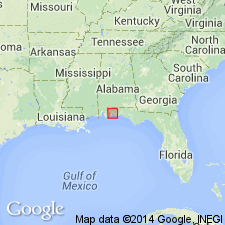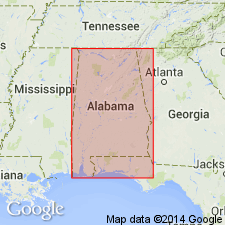
- Usage in publication:
-
- Escambia Sand Member*
- Modifications:
-
- Named
- Dominant lithology:
-
- Sand
- Gravel
- AAPG geologic province:
-
- Mid-Gulf Coast basin
Summary:
Formal proposal of name Pensacola Clay and Escambia Sand Member. Distribution of Escambia Sand Member everywhere coincides with distribution of upper unnamed member of Pensacola, for where upper member grades laterally into sand of Miocene coarse clastics, the Escambia loses its upper contact and becomes indistinguishable from Miocene coarse clastics. The Escambia thickens southwestward from minimum of 20 ft at Chemstrand Plant, about 6 mi north of mouth of Escambia River, to maximum of 160 ft in area 4.5 mi west of mouth of Perdido River. The Escambia consists predominantly of light-gray to brownish-gray fine to coarse quartz sand. Northwest of Pensacola, the member is made up of very coarse sand and quartz granules in lower part and pea-size gravel in upper part. In southern Santa Rosa Co., member contains some carbonaceous material and an abundance of black grains, possible phosphate, in lower 5 ft. Escambia is represented in all three oil test holes of Pensacola type section, but is best displayed in Temple-Sherrill No. 1, Baldwin Co., AL.
Source: GNU records (USGS DDS-6; Reston GNULEX).

- Usage in publication:
-
- Escambia Sand Member
- Modifications:
-
- Overview
- Areal extent
- AAPG geologic province:
-
- Mid-Gulf Coast basin
Summary:
Escambia, the only named member of Pensacola Clay, occurs between two unnamed clay units. Escambia is a gray fine- to very coarse-grained micaceous quartz sand locally containing small pebbles and granules of quartz, shells, and carbonaceous plant fragments. Present in subsurface of Mobile and Baldwin Cos, AL. Age is Miocene.
Source: GNU records (USGS DDS-6; Reston GNULEX).
For more information, please contact Nancy Stamm, Geologic Names Committee Secretary.
Asterisk (*) indicates published by U.S. Geological Survey authors.
"No current usage" (†) implies that a name has been abandoned or has fallen into disuse. Former usage and, if known, replacement name given in parentheses ( ).
Slash (/) indicates name conflicts with nomenclatural guidelines (CSN, 1933; ACSN, 1961, 1970; NACSN, 1983, 2005, 2021). May be explained within brackets ([ ]).

